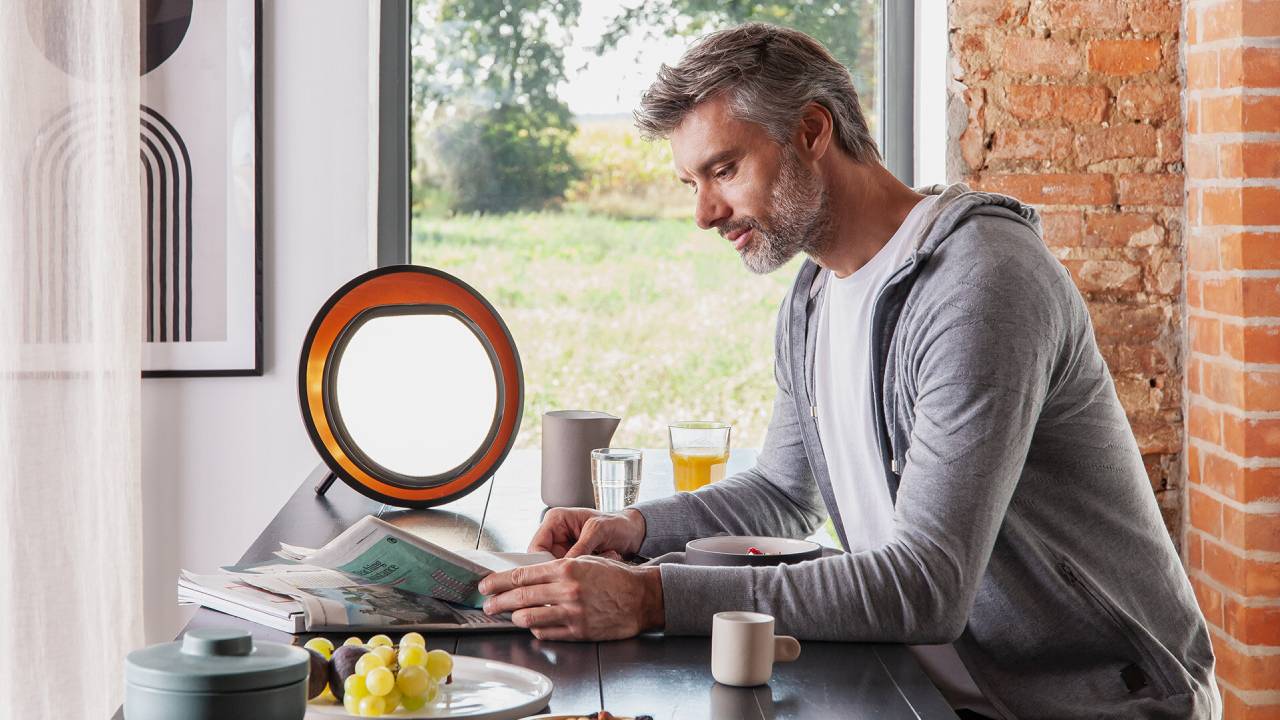How to use a SAD lamp: tips on getting the most out of light therapy
Feel the positive effects of light therapy with this handy guide on how to use a SAD lamp


With the clocks going back at the end of October, we’re officially into the Autumn/Winter months, where the temperature gets colder and the days get darker. During this time of year, many people experience or suffer with Seasonal Affective Disorder (SAD) which can make everyday tasks extremely challenging.
If you’re showing signs of SAD, one of the best ways to combat these symptoms and improve your mood and motivation is by investing in the best SAD lamps. SAD lamps are light therapy devices that simulate sunlight and have been medically recommended as treatments for SAD.
As the winter months have a distinct lack of sunlight, this not only affects your body clock and mood, but it also affects the production of serotonin and melatonin. So, by adding a SAD lamp into your home, you can use light therapy to help boost energy, keep you more alert and in better control of your SAD symptoms.
If you’re unsure how to use a SAD lamp, here’s our comprehensive guide on how to get the most out of SAD light therapy, plus general advice on when to use them and how long to use them for. For more SAD tips, see 5 soothing sleep tips for SAD sufferers.
Please note: T3 are not health professionals and if you think you might be suffering from SAD, please see a doctor and ask a professional before buying a SAD lamp.
How to use a SAD lamp: step-by-step
Interested in a SAD lamp but don’t know which to pick or how to use it? Follow the steps below to get started using a SAD lamp.
1. Choose the right SAD lamp for you
Get all the latest news, reviews, deals and buying guides on gorgeous tech, home and active products from the T3 experts
Firstly, you’ll need to choose a SAD lamp. Rather than using an ordinary lamp, SAD lamps emit a certain amount of light which has an effect on your mood and adds the right brightness to your room. The recommended brightness for a SAD lamp is 10,000 lux. According to Psychology Today, you should also look for a SAD lamp which provides a full spectrum of white light and blocks or filters out ultraviolet rays which are harmful to the body.
Overall, when you buy a SAD lamp, make sure it’s specifically designed to be used for SAD and comes with guidelines on brightness and how long you should use it for. For specific recommendations, we’ve got a guide to the best SAD lamps on the market, including the Beurer TL50 Light Therapy Lamp and the Lumie Halo so take a look for our top picks.

2. Position your SAD lamp
The positioning and distance of your SAD lamp is very important. Because of the brightness and intensity of the light, having your SAD lamp too close to you can be damaging to your eyes. Start by positioning your SAD lamp at eye level or higher, and angling it slightly rather than having it face-on, so you can see the sunlight but you’re not looking directly at it.
In terms of how far you should be from your SAD lamp, it’s worth noting that the intensity of the lamp will decrease with distance, e.g. if your lamp is 10,000 lux at 16cm, if you’re 30cm away from it, you’ll get 5,000 lux. Many brands recommend that you sit 2 feet or 60cm away from the SAD lamp to get the full effects.
3. Use your SAD lamp consistently
Daily use of your SAD lamp is more likely to improve your mood, help with motivation and calm your thoughts, so it’s important to use it consistently. Experts recommend that you should use a SAD lamp everyday from early autumn to mid winter but make sure to read your SAD lamp instructions for specific time frames.
4. Monitor your mood after each usage
While there’s mixed evidence about the effectiveness of SAD lamps, many people who use them consistently have noted that they saw an improvement in their SAD symptoms when using one. So, to ensure you're getting the most out of your SAD lamp, keep a diary and monitor your mood after each use to see if it’s helping you.
How long should I use my SAD lamp for?
According to Mayo Clinic, you should use your SAD lamp for 20-30 minutes. However, this is different for everyone and it will depend on how far you sit from your SAD lamp. For example, if you sit quite close to your SAD lamp, you’re getting the full recommended 10,000 lux and you should only need a maximum of 30 minutes in front of it. If you’re further away and getting 5,000 lux, you can use it for 30 minutes up to an hour.

What time of day should I use my SAD lamp?
Experts recommend using a SAD lamp first thing in the morning, typically within the first hour of waking up. Mind Your Head says that bright light in the morning has been shown to be more effective, but early evening light exposure can be beneficial, too. Once you find out which time works best for you, stick to it for the best results.
When to NOT use a SAD lamp
There’s a difference between having trouble adjusting to the darker evenings and having SAD which is a form of depression with a seasonal pattern. If you’re simply finding it hard to wake up in the mornings due to the darkness, trying one of the best wake up lights could be more beneficial than a SAD lamp.
Other reasons to not use a SAD lamp is if you experience any side effects or you have any eye problems. As SAD lamps use bright light, looking directly at them can hurt your eyes and cause agitation, headaches, sleeping problems, tiredness and blurred vision, according to the NHS. If you’ve been told to avoid bright lights by your doctor or you’ve had major eye surgery, you should avoid using a SAD lamp, but as always, speak to a health professional before buying or using one.

Beth is Home Editor for T3, looking after style, living and wellness. From the comfiest mattresses to strange things you can cook in an air fryer, Beth covers sleep, smart home, coffee machines, watches, grooming tools, fragrances, gardening and more.
In her spare time, Beth enjoys running, reading, baking and attempting craft projects that will probably end in disaster!